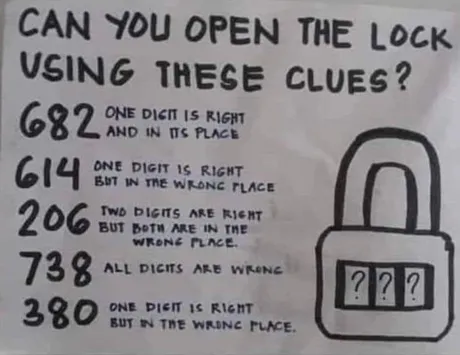
These pictures have been sitting in my to-do folder since April 14th. You'd of thought I'd had time for a filler episode by then, but I guess not!
The following puzzle was presented to me in Discord on the PAL server. I got the answer right but I was told my answer was wrong. I checked my answer and doubled down. No dice. Then I found the answer online (which was my answer) and was accused of cheating. LOL :D
https://www.youtube.com/results?search_query=can+you+open+the+lock+using+these+clues
In any case, I created four slides to best explain how to "crack" problems like this. The best way to go about it is to work backwards or find the easiest clue that gives the largest quantity of information and go from there. In this case clue #4 gives the most information.
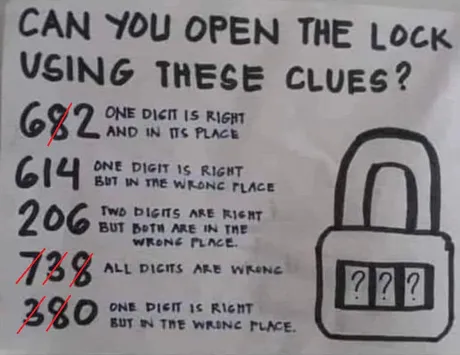
Clue #4 & #5
This clue is definitely the easiest to parse. Simply cancel out all the false numbers. In combination with clue #5, we see that 0 is one of the numbers, and it does not belong in the third slot.

Clue #3
From here, we see that 0 is a correct number and it also does not belong in the second slot. Using deduction, there is only one slot left, so zero must appear in the first tumbler.
Deduction has theories that predict an outcome, which are tested by experiments. Induction makes observations that lead to generalizations for how that thing works. If the premises are true in deduction, the conclusion is definitely true. If the premises are true in induction, the conclusion is probably true.
Remember all those times Sherlock Holmes said, "I deduce..."?
Yeah, even he was wrong.
The method he was using was induction (intuition).
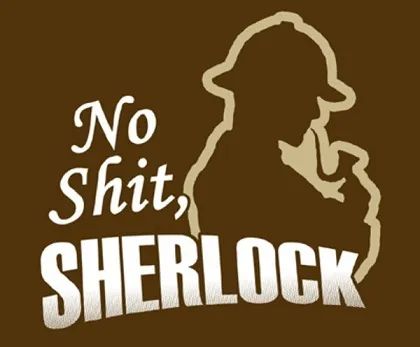
Sherlock Holmes never uses deductive reasoning to assist him in solving a crime. Instead, he uses inductive reasoning. So what is the difference? Deductive reasoning starts with a hypothesis that examines facts and then reaches a logical conclusion.
The more you know, the more you don't know!
There are a lot of conspiracy theories on Hive, that much is certain. This kind of global thinking uses inductive reasoning to reach the conclusions. Because much of the evidence and logical jumps involving conspiracy theory can easily be wrong (or at least not perfectly correct) it is easy to make false conclusions (or simply not be able to convince others of the same "truth").
Back to the puzzle!
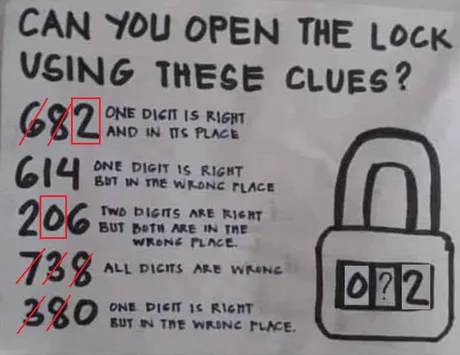
Clue #1
Now that we know zero belongs in the first tumbler this clue tells us that two must be correct and in the third slot, because it is impossible for 6 or 8 to be correct. This allows us to cancel all 6's off the table because 0 is already guaranteed to be the first digit.
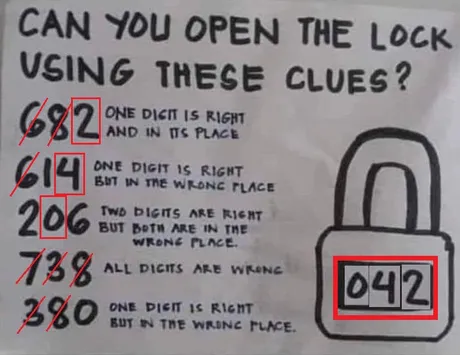
And Finally: Clue #2
We knew six was incorrect from the previous clue, and 1 can not be correct either because it needs to be in the "wrong place". This leaves 4 as the only option left.
Puzzle solved: 042
I was given 1 Hive for solving the problem by some crazy French lady :D

She was in Discord being all risque with us nerds and @klye accused her of being his catfishing friend. Apparently that is a common occurrence. Back me up @klye! Unfortunately it's hard to describe the tone change when she jumped into voice and spoke, and ended up not being a catfishing troll. If you've ever played video games with a bunch of sex-starved dorks and then a girl jumps into chat, you know exactly what I'm talking about. kek. Needless to say, I was embarrassed for my 21 year-old self. Luckily, that was eons ago.
Conclusion
I remember when I was a kid a drew a few mazes when I was bored at school. The first few I drew were a bit too easy to solve, so I started drawing them from the finish line and worked my way back to the start. This made the puzzle much more difficult for those who started at the proclaimed beginning. The same can be said for a lot of puzzles, this one included.
It's also much easier to sort these things out with a pen and paper, working out the issue methodically rather than just trying to "wing it" with the information presented. As luck would have it, these same strategies can also be used to create a puzzle like this in the first place.
One day I hope the create some kind of puzzle game on Hive. It would be nice to have another proof-of-brain activity separate from blogging and the social media aspect of the chain. We are so focused on this aspect that many of the mechanics embedded into our very consensus layer (curation) cater directly to this one activity. Many of us are so focused on the blogging side of things that we ignore all the other cool stuff that could be built here and base many of our plans for the future around a single one-trick pony. I hope to change that line of thinking eventually. One can hope.
Return from Filler Episode: Silly Math Puzzle. to edicted's Web3 Blog
